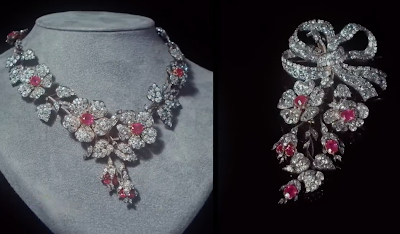 |
| Crown of Wüttemberg, Landesmuseum in Stuttgart, Germany |
Our spotlight today is on the royal jewels of the Kingdom of Württemberg. The Kingdom of Württemberg was a German state that existed from 1805 to 1918 (ended by World War I with Germany's defeat).
Today the area is known as Baden-Württemberg. It is 13,804 square miles (or 35,752 square km), which is 1/3 the size of Kentucky in the USA. From 1495 - 1805, the territory located in Southwest Germany was called the Duchy of Württemberg and from 1495 to 1268, Württemberg was a county in the former Duchy of Swabia. So suffice it to say that Württemberg has a long history. What's more, Württemberg was a cultural center in the 19th century, and its major city, Stuttgart, still exists today.


Diamond Jewels including the Wüttemberg Diamond Wedding Diadem (top left)
A majority of European royal families including those in the United Kingdom, Sweden, Spain, Norway, the Netherlands, Luxembourg, Liechtenstein, Denmark, and Belgium are descendants of the House of Württemberg (founded in 1081) because until recently royals only married other royals.
The Württemberg Pink Topez Parure
After World War I toppled centuries-old dynasties (in 1918), the German kings, princes, and grand dukes lost their titles and realms, yet were allowed to keep their castles and wealth including their magnificent jewelry. As time passed into the modern era, sometimes these jewels were auctioned off to raise money; or through marriages and/or purchases ended up on the heads of Europe's surviving royal families. With the fall of more European dynasties at the end of World War II (in 1945), additional royal family jewels were sold sometimes to anonymous rich buyers, and the whereabouts of some of these historic pieces became unknown.
The Diamond and Natural Pearl Devant de Corsage was created by Emil Biedermann in 1865
Many of the Württemberg jewels featured in today's blog came up for auction at Christie's in 2023, each selling for a hefty sum. You may wonder what makes royals sell their dynastic jewelry: 1), They may need the money for living expenses; 2) Without state functions to host or attend, they don't need such ornate pieces as a sign of power as in the past; 3) Since they no longer have the same wealth or power as when they lorded over a territory, it makes sense to downsize (i.e., no insurance or security to worry about.)
Diamonds, rubies, and sapphires, oh, my, what pretty eye candy! Which pieces are your favorites? Mine are the diamond jewels -- the necklace and the diamond wedding diadem which I'd wear to something even if I had to create the event! Of course, I love the rubies and sapphires too but think the diamond necklace is more wearable.
Natural Pearl and Diamond Pearl Brooch (left) and Queen Maxima of the Netherlands (right) wearing the Wüttemberg Ornate Natural Pearl Tiara with a 5-string matching Natual Pearl Necklace and Earrings for the state dinner in Japan in 1914.












Wow, these are sumptuous royal jewels. I was surprised to see Queen Maxima wearing a Wuttemberg tiara - I guess the Netherlands must have acquired/inherited pieces from Wuttemberg at some stage. I am a sucker for pink, so love the pink topaz pieces best of all, in my Princess dreams. The pearl and diamond pieces are very, very nice too. What good taste they had back in the day. So sad they are selling off, but better than being stolen in a war or something like that.
ReplyDeleteI love the peals too and really all the jewelry. We can't go wrong with whatever we would pick! I always hope these dynastic pieces find their way into a museum.
Delete